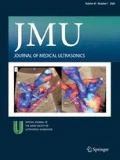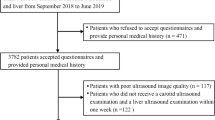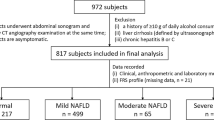Abstract
Purpose
The aim of the study was to determine the involvement of non-alcoholic fatty liver disease (NAFLD) in myocardial infarction patients and its relation with carotid intima-media thickness (CIMT).
Methods
This study consisted of 224 patients divided into three groups: those with myocardial infarction (MI), stable coronary artery disease (CAD), and normal coronary artery. Measurement of CIMT and abdominal ultrasonography for hepatosteatosis was performed in all participants.
Results
NAFLD was significantly more frequent among MI patients compared to the other groups. There was a significant difference between CAD and the presence of NAFLD (p < 0.05). Also, we found significant correlations between the severity of CAD and hepatosteatosis grade (r = 0.648, p < 0.001), CAD and CIMT (r = 0.594, p < 0.001), and NAFLD and CIMT (r = 0.233, p = 0.005). NAFLD was also significantly correlated with the severity of CAD (r = 0.607, p < 0.001), and the grade of NAFLD significantly correlated with CIMT (r = 0.606, p < 0.001).
Conclusion
Patients with more severe CAD were more likely to have NAFLD. In addition, hepatosteatosis may be associated with coronary plaque instability and high fatty volume. Patients with NAFLD should be screened regularly for other cardiovascular risk factors, and the presence of fatty liver may help better classify these patients.

Similar content being viewed by others
References
Brunt EM, Janney CG, Di Bisceglie AM, et al. Nonalcoholic steatohepatitis: a proposal for grading and staging the histological lesions. Am J Gastroenterol. 1999;94:2467–74.
Farrell GC, Larter CZ. Nonalcoholic fatty liver disease: from steatosis to cirrhosis. Hepatology. 2006;43:99–112.
Musso G, Gambino R, Bo S, et al. Should nonalcoholic fatty liver disease be included in the definition of metabolic syndrome? A cross-sectional comparison with Adult Treatment Panel III criteria in nonobese nondiabetic subjects. Diabet Care. 2008;31:562–8.
Marchesini G, Marzocchi R, Agostini F, et al. Non-alcoholic fatty liver disease and the metabolic syndrome. Curr Opin Lipidol. 2005;16:421–7.
Assy N, Kaita K, Mymin D, et al. Fatty infiltration of liver in hyperlipidemic patients. Dig Dis Sci. 2000;45:1929–34.
Donati G, Stagni B, Piscaglia F, et al. Increased prevalence of fatty liver in arterial hypertensive patients with normal liver enzymes: role of insulin resistance. Gut. 2004;53:1020–3.
Akahoshi M, Amasaki Y, Soda M, et al. Correlation between fatty liver and coronary risk factors: a population study of elderly men and women in Nagasaki. Jpn Hypertens Res. 2001;24:337–43.
Malik S, Wong ND, Franklin SS, et al. Impact of the metabolic syndrome on mortality from coronary heart disease, cardiovascular disease, and all causes in United States adults. Circulation. 2004;110:1245–50.
Targher G. Non-alcoholic fatty liver disease, the metabolic syndrome and the risk of cardiovascular disease: the plot thickens. Diabet Med. 2007;24:1–6.
Brea A, Mosquera D, Martin E, et al. Nonalcoholic fatty liver disease is associated with carotid atherosclerosis. A case control study. Arterioscler Thromb Vasc Biol. 2005;25:1045–50.
Thygesen K, Alpert SA, White HD, et al. Universal definition of myocardial infarction. Eur Heart J. 2007;28:2525–38.
Third report of the national cholesterol education program. (NCEP) expert panel on detection, evaluation, and treatment of high blood cholesterol in adults (ATP III) final report. Circulation. 2002;106:3143–421.
Lang RM, Bierig M, Devereux RB, et al. American society of echocardiography nomenclature and standards committee; task force on chamber quantification; American College of Cardiology Echocardiography Committee; American Heart Association; European Association of Echocardiography, European Society of Cardiology. Recommendations for chamber quantification. Eur J Echocardiogr. 2006;7:79–108.
Leaman DM, Brower RW, Meester GT, et al. Coronary artery atherosclerosis: severity of the disease, severity of angina pectoris and compromised left ventricular function. Circulation. 1981;63:285–9.
Gensini GG. A more meaningful scoring system for determining the severity of coronary heart disease. Am J Cardiol. 1983;51:606.
Osawa H, Morry Y. Sonographic diagnosis of fatty liver using a histogram technique that compares liver and renal cortical echo amplitudes. J Clic Ultrasound. 1996;24:25–9.
el-Hassan AY, Ibrahim EM, al-Mulhim FA, et al. Fatty infiltration of the liver: analysis of prevalence, radiological and clinical features and influence on patient management. Br J Radiol. 1992;65:774–8.
Mulhall BP, Ong JP, Younossi ZM. Non-alcoholic fatty liver disease: an overview. J Gastroenterol Hepatol. 2002;17:1136–43.
Lin YC, Lo HM, Chen JD. Sonographic fatty liver, overweight and ischaemic heart disease. World J Gastroenterol. 2005;11:4838–42.
Targher G, Bertolini L, Padovani R, et al. Increased prevalence of cardiovascular disease among type 2 diabetic patients with nonalcoholic fatty liver disease. Diabet Med. 2006;23:403–9.
Arslan U, Türkoğlu S, Balcioğlu S, et al. Association between nonalcoholic fatty liver disease and coronary artery disease. Coron Artery Dis. 2007;18:433–6.
Ekstedt M, Franzén LE, Mathiesen UL, et al. Long-term follow-up of patients with NAFLD and elevated liver enzymes. Hepatology. 2006;44:865–73.
Villanova N, Moscatiello S, Ramilli S, et al. Endothelial dysfunction and cardiovascular risk profi le in nonalcoholic fatty liver disease. Hepatology. 2005;42:473–80.
Hamaguchi M, Kojima T, Takeda N, et al. The metabolic syndrome as a predictor of nonalcoholic fatty liver disease. Ann Intern Med. 2005;143:722–8.
Targher G, Zenari L, Bentolini L, et al. Relations between carotid artery wall thickness and liver histology in subjects with nonalcoholic fatty liver disease. Diabet Care. 2006;29:1325–30.
Hodis HN, Mack WJ, LaBree L, et al. The role of carotid arterial intima-media thickness in predicting clinical coronary events. Ann Intern Med. 1998;128:262–9.
Lorenz MW, Markus HS, Bots ML, et al. Prediction of clinical cardiovascular events with carotid intima-media thickness: a systematic review and meta-analysis. Circulation. 2007;115:459–67.
Targher G, Bertolini L, Poli F, et al. Nonalcoholic fatty liver disease and risk of future cardiovascular events among type 2 diabetic patients. Diabetes. 2005;54:3541–6.
Author information
Authors and Affiliations
Corresponding author
Ethics declarations
Conflict of interest
There are no financial or other relations that could lead to a conflict of interest.
Human rights statements and informed consent
All procedures followed were in accordance with the ethical standards of the responsible committee on human experimentation (institutional and national) and with the Helsinki Declaration of 1975, as revised in 2008. Informed consent was obtained from all patients for being included in the study.
About this article
Cite this article
Öztürk, H., Gümrükçüoğlu, H.A., Yaman, M. et al. Hepatosteatosis and carotid intima-media thickness in patients with myocardial infarction. J Med Ultrasonics 43, 77–82 (2016). https://doi.org/10.1007/s10396-015-0649-x
Received:
Accepted:
Published:
Issue Date:
DOI: https://doi.org/10.1007/s10396-015-0649-x




